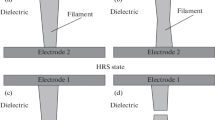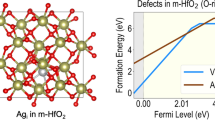Abstract
A theoretical model that describes the degradation of the resistive states of the memristor over time has been proposing. It has been showing that the current through the memristor cell is limiting by tunneling through the barrier at the nonstoichiometric oxide/metal interfaces. Degradation of the resistive state is generated by diffusive dissolution of the conductive channel. It leads to a change in the space charge region of the metal/dielectric interface. The impact of the filament cross-section, the width of the rupture region, and vacancy concentration in this area on the degradation of HRS and LRS states were investigated. The model explains various kinds of memristor degradation observed in the experimental works of different authors. The connection between the type of degradation and the filament parameters/environment of the dielectric has been demonstrating.







Similar content being viewed by others
REFERENCES
Lanza, M., Wong, H.-S.P., Pop, E., Ielmini, D., Strukov, D., Regan, B.C., Larcher, L., Villena, M.A., Yang, J.J., Goux, L., Belmonte, A., Yang, Y., Puglisi, F.M., Kang, J., Magyari-Köpe, B., et al., Recommended methods to study resistive switching devices, Adv. Electron. Mater., 2018, vol. 1800143, pp. 1–28.
Fadeev, A.V. and Rudenko, K.V., To the issue of the memristor’s HRS and LRS states degradation, Russ. Microelectron., 2021, vol. 50, no. 5, pp. 311–325.
Kumar, A., Das, M., Garg, V., Sengar, B.S., Htay, M.T., Kumar, S., Kranti, A., and Mukherjee, S., Forming-free high-endurance Al/ZnO/Al memristor fabricated by dual ion beam sputtering, Appl. Phys. Lett., 2017, vol. 110, p. 253509.
Wang, G., Long, S., Yu, Z., Zhang, M., Li, Y., Xu, D., Lv, H., Liu, Q., Yan, X., Wang, M., Xu, X., Liu, H., Yang, B., and Liu, M., Impact of program/erase operation on the performances of oxide-based resistive switching memory, Nanoscale Res. Lett., 2015, vol. 10, p. 39.
Kim, W., Hardtdegena, A., Rodenbüchera, C., Menzela, S., Woutersb, D.J., Hoffmann-Eiferta, S., Bucaa, D., Wasera, R., and Rana, V., Forming-free metal-oxide ReRAM by oxygen ion implantation process, in Proceedings of the IEEE International Electron Devices Meeting (IEDM), San Francisco: CA, 2016, pp. 4.4.1–4.4.4.
Gao, B., Zhang, H., Chen, B., Liu, L., Liu, X., Han, R., Kang, J., Fang, Z., Yu, H., and Yu, B., Modeling of retention failure behavior in bipolar oxide-based resistive switching memory, IEEE Electron Dev. Lett., 2011, vol. 32, no. 3, pp. 276–278.
Wei, Z., Takagi, T., Kanzawa, Y., Katoh, Y., Ninomiya, T., Kawai, K., Muraoka, S., Mitani, S., Katayama, K., Fujii, S., Miyanaga, R., Kawashima, Y., Mikawa, T., Shimakawa, K., and Aono, K., Demonstration of high-density ReRAM ensuring 10-year retention at 85°C based on a newly developed reliability model, in Proceedings of the IEEE International Electron Devices Meeting, Washington, DC, 2011, pp. 31.4.1–31.4.4.
Wei, Z., Takagi, T., Kanzawa, Y., Katoh, Y., Ninomiya, T., Kawai, K., Muraoka, S., Mitani, S., Katayama, K., Fujii, S., and Miyana, R., Retention model for high-density ReRAM, in Proceedings of the IEEE International Memory Workshop, Milan, Italy, 2012, pp. 1–4.
Chen, N.H., Zheng, Z.W., Cheng, C.H., and Yeh, F.S., Sub-micro watt resistive memories using nano-crystallized aluminum oxynitride dielectric, Appl. Phys. A, 2014, vol. 116, pp. 575–579.
Prakash, A., Jana, D., Samanta, S., and Maikap, S., Self-compliance-improved resistive switching using Ir/TaOx/W cross-point memory, Nanoscale Res. Lett., 2013, vol. 8, p. 527.
Srivastava, S., Defect-rich size-selected nanoclusters and nanocrystalline films of titanium(IV) oxide and tantalum(IV) oxide for efficient photocatalyst and electroforming-free memristor applications, Thesis, Waterloo, Canada: Univ. Waterloo, 2016.
Kim, K.M., Zhang, J., Graves, C., Yang, J.J., Choi, B.J., Hwang, C.S., Li, Z., and Williams, R.S., Low-power, self-rectifying, and forming-free memristor with an asymmetric programing voltage for a high-density crossbar application, Nano Lett., 2016, no. 11, pp. 6724–6732.
Ninomiya, T., Takagi, T., Wei, Z., Muraoka, S., Yasuhara, R., Katayama, K., Ikeda, Y., Kawai, K., Kato, Y., Kawashima, Y., Ito, S., Mikawa, T., Shimakawa, K., and Aono, K., Conductive filament scaling of TaOx bipolar ReRAM for long retention with low current operation, in Proceedings of the Symposium on VLSI Technology, 2012.
Gao, B., Zhang, H., Chen, B., Liu, L., Liu, X., Han, R., Kang, J., Fang, Z., Yu, H., Yu, B., and Kwong, D.-L., Modeling of retention failure behavior in bipolar oxide-based resistive switching memory, IEEE Electron Dev. Lett., 2011, vol. 32, no. 3, pp. 276–278.
Mazady, A., Modeling, fabrication, and characterization of memristors, Doctoral Dissertation, 2014, p. 660.
Dai, Y., Zhao, Y., Wang, J., Xu, J., and Yang, F., First principle simulations on the effects of oxygen vacancy in HfO2-based RRAM, AIP Adv., 2015, vol. 5, p. 017133.
Larentis, S., Nardi, F., Balatti, S., Gilmer, D.C., and Ielmini, D., Resistive switching by voltage-driven ion migration in bipolar RRAM, Part II: Modeling, IEEE Trans. Electron Dev., 2012, vol. 59, no. 9, pp. 2468–2475.
Noman, M., Jiang, W., Salvador, P.A., Skowronski, M., and Bain, J.A., Computational investigations into the operating window for memristive devices based on homogeneous ionic motion, Appl. Phys. A: Mater. Sci. Process, 2011, vol. 102, pp. 877–883.
Lee, S.H., Moon, J., Jeong, Y., Lee, J., Li, X., Wu, H., and Lu, W., Quantitative, dynamic TaOx memristor/resistive random access memory model, ACS Appl. Electron. Mater., 2020, vol. 2, no. 3, pp. 701–709.
Kim, K.-H., Jo, S.H., Gaba, S., and Lu, W., Nanoscale resistive memory with intrinsic diode characteristics and long endurance, Appl. Phys. Lett., 2010, vol. 96, p. 053106.
Carslow, H.S. and Jaeger, J.C., Conduction of Heat in Solids, Oxford: Oxford Univ. Press, 1948, p. 386.
Jiang, H., Han, L., Lin, P., Wang, Z., Jang, M.H., Wu, Q., Barnell, M., Yang, J.J., Xin, H.L., and Xia, Q., Sub-10 nm Ta channel responsible for superior performance of a HfO2 memristor, Sci. Rep., 2016, vol. 6, p. 28525.
Wang, L.-G., Qian, X., Cao, Y.-Q., Cao, Z.-Y., Fang, G.-Y., Li, A.-D., and Wu, D., Excellent resistive switching properties of atomic layer-deposited Al2O3/HfO2/Al2O3 trilayer structures for non-volatile memory applications, Nan. Res. Lett., 2015, vol. 10, p. 35.
Xiao, N., Villena, M.A., Yuan, B., Chen, Sh., Wang, B., Eliáš, M., Shi, Y., Hui, F., Jing, X., Scheuermann, A., Tang, K., McIntyre, P.C., and Lanza, M., Resistive random access memory cells with a bilayer TiO2/SiOx. Insulating stack for simultaneous filamentary and distributed resistive switching, Adv. Funct. Mater., 2017, p. 1700384.
Brillson, L.J. and Lu, Y., ZnO Schottky barriers and ohmic contacts, J. Appl. Phys., 2011, vol. 109, p. 121301.
Gu, D. and Dey, S.K., Effective work function of Pt, Pd, and Re on atomic layer deposited HfO2, Appl. Phys. Lett., 2006, vol. 89, p. 082907.
Prada, S., Martinez, U., and Pacchioni, G., Work function changes induced by deposition of ultrathin dielectric films on metals: A theoretical analysis, Phys. Rev. B, 2008, vol. 78, p. 235423.
Yang, J.J., Borghetti, J., Murphy, D., Stewart, D.R., and Williams, R.S., A family of electronically reconfi-gurable nanodevices, Adv. Mater., 2009, vol. 21, pp. 3754–3758.
Shima, H., Zhong, N., and Akinaga, H., Switchable rectifier built with Pt/TiOx/Pt trilayer, Appl. Phys. Lett., 2009, vol. 94, p. 082905.
Jiang, W., Evans, D., Bain, J.A., Skowronski, M., and Salvador, P.A., Electron beam induced current investigations of Pt/SrTiO3–x interface exposed to chemical and electrical stresses, Appl. Phys. Lett., 2010, vol. 96, p. 092102.
Marchewka, A., Roesgen, B., Skaja, K., Du, H., Jia, C.L., Mayer, J., Rana, V., Waser, R., and Menzel, S., Nanoionic resistive switching memories: On the physical nature of the dynamic reset process, Adv. Electron. Mater., 2016, vol. 2, pp. 1500233-1–13.
Sze, S.M. and Ng, K.K., Physics of Semiconductor Devices, Chichester: Wiley, 2006.
Kwon, D.H., Kim, K., Jang, J., et al., Atomic structure of conducting nanofilaments in TiO2 resistive switching memory, Nat. Nanotechnol., 2010, vol. 5, pp. 148–153.
Miller, A. and Abrahams, E., Impurity conduction at low concentrations, Phys. Rev., 1960, vol. 120, no. 3, pp. 745–755.
Broadbent, S.R. and Hammersley, J.M., Percolation processes. I. Crystals and mazes, Proc. Cambridge Phil. Soc., 1957, vol. 53, pp. 629–641.
Govoreanu, B., Kar, G.S., Chen, Y.-Y., Paraschiv, V., Kubicek, S., Fantini, A., Radu, I.P., Goux, L., Clima, S., Degraeve, R., Jossart, N., Richard, O., Vandeweyer, T., Seo, K., Hendrickx, P., et al., 10 × 10 nm2 Hf/HfOx crossbar resistive RAM with excellent performance, reliability and low-energy operation, in Proceedings of the International Electron Devices Meeting, Washington, DC, 2011, pp. 31.6.1–31.6.4.
Funding
This study was supported by the Program no. FFNN-2022-0019 of the Ministry of Science and Higher Education of Russia for Valiev Institute of Physics.
Author information
Authors and Affiliations
Corresponding authors
Ethics declarations
The authors declare that they have no conflicts of interest.
Rights and permissions
About this article
Cite this article
Fadeev, A.V., Rudenko, K.V. Analysis of the Effects Influencing the Retention Time of Filament-Based Memristors. Russ Microelectron 51, 264–272 (2022). https://doi.org/10.1134/S1063739722040059
Received:
Revised:
Accepted:
Published:
Issue Date:
DOI: https://doi.org/10.1134/S1063739722040059




